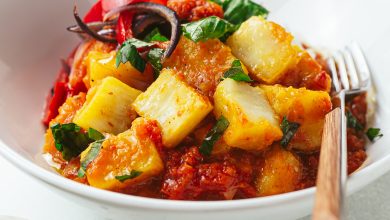Masa Recipe – A Delightful Dish for Every Occasion
Masa, a traditional dish with deep-rooted cultural significance, combines simplicity with flavor. Often made from rice, yeast, and sugar, it serves as a hearty base for savory meals or can be enjoyed on its own with a crispy golden finish. Its preparation involves fermenting a rice-based batter before cooking it to achieve a delightful texture. Below, you will find a detailed step-by-step guide to making this versatile dish.
Ingredients
| Ingredient | Quantity | Notes |
|---|---|---|
| Rice | 2 cups | White or brown rice works well |
| Cooked Rice | 1/2 cup | To help form the paste |
| Yeast | 1 tablespoon | Active dry yeast |
| Sugar | 1 tablespoon | For slight sweetness |
| Water | As needed (1/2 to 1 cup) | To form a batter consistency |
Allergen Information
- Gluten: This recipe does not contain gluten, making it suitable for those following a gluten-free diet, assuming all ingredients are verified to be gluten-free.
- Dairy: The recipe is dairy-free, suitable for those who are lactose intolerant or following a dairy-free lifestyle.
- Other allergens: The ingredients listed are typically considered safe for most, though always check for cross-contamination risks if using packaged rice or yeast.
Dietary Preferences
- Vegetarian: This recipe is naturally vegetarian, as it contains no animal-based products.
- Vegan: This dish is also suitable for vegans, provided that the yeast used is vegan-friendly (most store-bought active dry yeasts are).
- Gluten-Free: With rice as the base, this dish can be enjoyed by those avoiding gluten.
- Dairy-Free: No dairy is involved in this recipe.
Procedure
-
Prepare the Rice Paste: Start by grinding 2 cups of uncooked rice with half a cup of cooked rice. The addition of cooked rice will make it easier to form a smooth, thick paste. Use a food processor or blender for a fine consistency, adding just enough water as needed to achieve a batter-like texture.
-
Mix the Ingredients: In a large bowl, combine the rice paste with 1 tablespoon of yeast and 1 tablespoon of sugar. Stir well to ensure the yeast and sugar are evenly distributed. Gradually add water, about half a cup to a full cup, until the mixture resembles a thick, pourable batter.
-
Let It Ferment: Cover the bowl with a clean cloth or plastic wrap and let the batter sit in a warm place for several hours, allowing the yeast to ferment. This process helps develop the characteristic flavor and texture of masa.
-
Cook the Masa: Once the batter has fermented, heat a special masa pan or a non-stick skillet over medium heat. Lightly grease the pan with a small amount of oil if necessary. Pour the batter into the pan, spreading it evenly to form a thin layer. Cook for about 5-7 minutes on each side or until golden and crispy. The texture should be slightly chewy on the inside with a crisp exterior.
-
Serve and Enjoy: Once your masa is golden and crispy, remove it from the pan and serve immediately. It can be enjoyed on its own, paired with a variety of toppings, or used as a base for other dishes.
Cooking Tips & Advice
- Fermentation Time: The longer you let the batter ferment, the more flavor it will develop. Typically, allowing it to rest for at least 3 hours works well, but for a deeper, more complex flavor, you can let it ferment for up to 6 hours.
- Consistency: If the batter seems too thick, you can add a bit more water to loosen it up. Just be cautious not to make it too runny, or it won’t cook properly.
- Masa Pan: A traditional masa pan or griddle will provide the best results, but a non-stick skillet works fine. The key is to ensure the pan is preheated before pouring the batter to achieve that perfect crispiness.
Conclusion
Masa is a wonderfully simple yet versatile dish, bringing together the flavors of rice, yeast, and sugar to create a base that can be enjoyed in many ways. Whether you prefer it as a snack or as part of a larger meal, its crispy texture and light sweetness make it a delightful addition to any table. Experiment with different toppings or pairings, and enjoy this traditional recipe that has stood the test of time.



